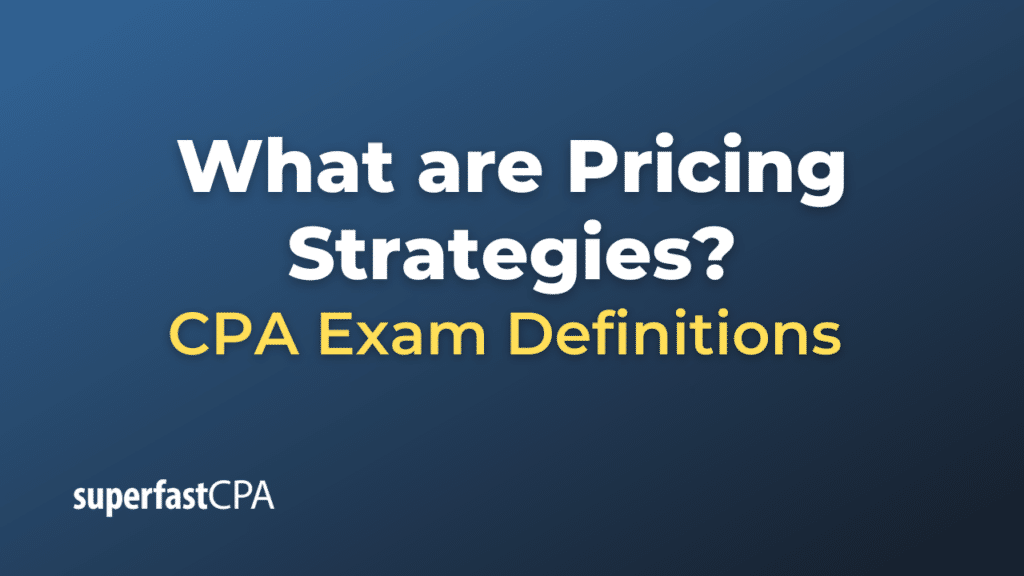Pricing Strategies
Pricing strategies are methods businesses use to price their products or services. These strategies are part of a company’s overall business model and directly impact revenue, profitability, and market position. There are several pricing strategies businesses can use, each suited to different situations and objectives. Here are a few common ones:
- cost-Plus Pricing: This strategy involves calculating the total cost to produce a product (including both direct and indirect costs) and then adding a markup percentage to determine the selling price. This approach ensures all costs are covered and a profit margin is secured, but it doesn’t take into account market demand or competition.
- Competitive Pricing: In this approach, businesses base their prices on what their competitors are charging. They may choose to price their products lower, equal, or higher than competitors, depending on their specific strategy and value proposition.
- Value-Based Pricing: This strategy involves setting prices based on the perceived value of the product or service to the customer, rather than on the cost of production or on the competition. If customers perceive high value in a product, they may be willing to pay a premium price for it.
- Penetration Pricing: Companies use this strategy to enter a new market. They initially set a low price to attract customers away from competitors and gain market share quickly. Once a substantial customer base is established, they may gradually increase the price.
- Skimming Pricing: This strategy is often used when a new, innovative, or high-demand product is introduced. The company sets a high price initially to “skim” maximum revenue layer by layer from the segments willing to pay the high price. The company then gradually lowers the price to capture more price-sensitive segments.
- Dynamic Pricing: Also known as surge pricing or demand pricing, this strategy involves adjusting prices in real-time based on market demand. This is common in industries like hospitality, tourism, and ride-sharing services.
- Psychological Pricing: This strategy is based on the idea that certain prices have a psychological impact on consumers. An example is setting the price at $9.99 instead of $10. The product seems cheaper to the consumer, even though the actual difference is just a few cents.
Each pricing strategy has its own advantages and disadvantages, and the best choice depends on many factors such as the company’s goals, target audience, product, market conditions, and competition. A good pricing strategy is crucial as it can directly influence the demand for the product and the company’s profitability.
Example of Pricing Strategies
Let’s go over an example of how different pricing strategies could be used in real-world business scenarios.
Example: An Innovative Tech Company
Let’s say you run an innovative tech company that’s about to launch a groundbreaking new smartphone with unique features not available on any other device in the market.
- Skimming Pricing: You could initially set a high price for the new smartphone. Early adopters and tech enthusiasts who value the unique features of your product would likely be willing to pay this premium price. As the market gets saturated and more competitors start to catch up with similar features, you could gradually reduce the price to attract more price-sensitive segments of the market.
- Value-Based Pricing: If the unique features of your smartphone offer significant value to customers (e.g., greatly improved productivity, unmatched user experience, etc.), you might set a high price that reflects this value. Here, the price isn’t based on the cost of production or what competitors are charging but on the perceived value to the customer.
- Dynamic Pricing: Suppose you also have an online platform for selling various digital services or products alongside the smartphone, like apps, music, movies, etc. You could use dynamic pricing for these digital goods based on factors like demand, time, user behavior, etc. For example, the price of a newly released popular movie might be higher due to high demand, and as demand falls, you could lower the price.
- Psychological Pricing: When setting the price for your smartphone or digital goods, you might decide to use a price ending in “.99” instead of a round number. So, you’d price the product at, say, $799.99 instead of $800. This strategy relies on the perception that $799.99 is significantly less than $800, making the product seem cheaper.
Remember, these are simplified examples. In reality, businesses often use a combination of various pricing strategies based on their target market, competition, product lifecycle stages, and other factors.













